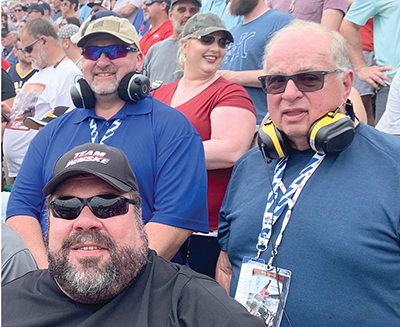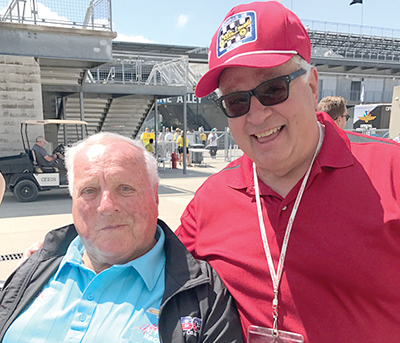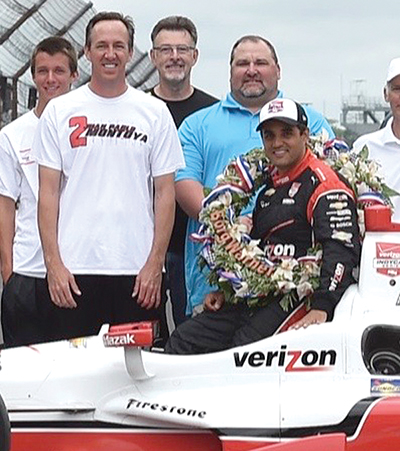Cains able
Dad, son extend decades-long Indy 500 streaks
Having an “Aunt Frieda” view of the Indianapolis 500 way back in 1947, held up to watch the open-wheel race cars zooming around Turn 2 as a 7-month old, Michael Cain of Farragut built his favorite hobby and profession around race cars.
He’s now center-stage among a four-generation love of this 500-mile jewel of open-wheel racing: the sporting event most associated with Memorial Day weekend nationwide.
With family streaks of attending the Indy 500 at “The Brickyard,” Indianapolis Motor Speedway, anywhere from 44 straight years to 55 out of 56 entering 2020, “My grandfather (Thomas Chaushoff) had a first cousin (Helen Giroff) that lived in Indianapolis, and my grandfather went to the race sometime in the late ’30s,” Michael said. “After World War II, my grandfather encouraged my father to go.
“Mom and dad (Eva and Floyd Cain) and I traveled by Greyhound bus from Detroit (living in Dearborn, Michigan) to attend the 1947 race,” he added.
Four years later, at 4 1/2, Michael remembered the 1951 race as “hot, crowded and ... running almost six hours — but I loved it.”
Moreover, “My father had the racing bug really bad and he enjoyed the 500 as much as my brother, Tom, and I did,” said Michael, who went on to become a Motorsports Marketing manager with General Motors Pontiac Division who, in 1989, was in charge of pace car operations for the 73rd 500.
“The 1989 Pace Car program was the highlight of my life up to then,” he added.
Also quite knowledgeable about NASCAR, which tied into his managerial work, Michael subsequently has formed close relationships with the famed Penske racing team family and three-time Indy champ Bobby Unser, among many other celebrated open wheel and NASCAR personalities.
If you count all relatives and close friends of the Cains who annually descend upon Indianapolis and the historic Speedway each year, “I would say there’s about 50 of us,” said Alex Cain, Michael’s son, whose unbroken streak of Indy 500 attendance dates back to age 5 in 1976.
“I have 32 tickets in my name,” Michael said. “… I still have cousins, aunts and uncles that attend races with us, some of them have been attending races since the 1960s.”
Looking back, “I would like to thank my Aunt Helen Giroff for fostering my racing interest,” Michael said about his late relative. “She lived about a mile from the Indy Speedway and I was always expected to stay with her.”
While her father, Thomas Giroff, owned a popular bar/pub/restaurant near the Speedway, “Helen often had a big get-together race weekend,” Michael said.
Helen’s niece, Deborah Giroff, is carrying on the family tradition of hosting the Cains and other family and friends each year at her home “about 5 miles from the Speedway,” Alex said.
The family tradition of annual attendance actually began in 1964 before the Cains discovered a special combination in 1965.
“My father was very excited about Ford and Lotus teaming up and winning the 500 with (driver) Jim Clark in 1965,” Michael said. “Jim Clark was our favorite. He always was in contention.”
More than 50 years later, the Cain family can still be found — during a regular year — on row 6 of Turn 4 (J Stand, Section 29).
Michael and his wife, Marti Cain, also passed on the Indy 500 tradition to their daughter, Karen Cain Harmon, who “always attended the race from an early age,” her father said.
Meanwhile, Alex got started rather young — only 6 weeks old. “My mother and Aunt Frieda brought (Alex) to the Speedway during the 1971 race like they did me in 1947,” Michael said.
Locally for Michael, Marti, Alex and other family members, their trek from Farragut begins about 10 days before the race to watch qualifying and enjoy other Indy 500-related events.
Adjusting at home, in August
Meanwhile, race officials exempted the Cain family from “missing” the 2020 Indy 500 — in which no fans were allowed due to coronavirus concerns, as the 500 was moved from its annual place on Sunday afternoon before Memorial Day to Sunday, Aug. 23.
As a result, the family streak of attending the 500 at Indianapolis Motor Speedway is now 45 straight for Alex, while Michael’s streak improves to 26 straight and 56 of the last 57.
Though forced to observe this year’s 104th running of the 500 at Michael and Marti’s Wyndham Hall home, decades-long traditions continued.
“We make the same type of sandwiches we did in 1964,” Michael said. “They are made the night before and everyone is assigned a job for correct construction.”
Alex, an assistant football coach at Farragut High School and criminal justice teacher at Gibbs High School, said the 2020 Indy 500 “was good because we were all together as friends, family.”
However, “it was very difficult to enjoy the race,” he added. “It’s because I could not make that physical connection with it on the television screen.
“You couldn’t hear it, you couldn’t feel it, you couldn’t smell it. … You don’t smell the rubber from the tires and the exhaust. … You don’t smell the ethanol they use for the fuel.”
A huge fan of A.J. Foyt, four-time Indy 500 champ, Alex’s love for the 500 was so strong, “I drove to Indianapolis to be at the Speedway on Memorial Day weekend” this year despite no race.
Comparing the Speedway and the 500 to another famed venue, “I can’t tell you how many University of Michigan football games I’ve been to in the ‘Big House,’” Alex said about the 107,000-seat Michigan Stadium in Ann Arbor.
“But it’s still not the same as going to the Speedway with a half-million people there,” he added, with one piece of advice thrown in: “everyone needs to attend the Indy 500 at least once.”






